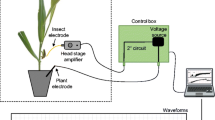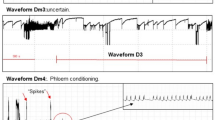Abstract
The brown marmorated stink bug (BMSB), Halyomorpha halys Stål, has dispersed throughout the northern hemisphere, causing disturbances in agroecosystems and urban areas. Studies are, therefore, needed on the biology, physiology, and ecology of BMSB. This project characterized and partially correlated (via histology of plant tissues) the DC electropenetrography (EPG) waveforms related to non-probing (NP and Z) and both salivary sheath and cell rupture feeding. BMSB feeding behaviors were analyzed in comparison with the five other EPG waveform characterization papers published to date for heteropteran insects. Waveforms consisted of epidermal scanning (Hh1), pathway of stylets through leaf tissue (Hh2), X waves (Hh3), and sustained vascular ingestion (Hh4). In addition, a cell-rupturing phase in mesophyll (Hh2) and putative ingestion of resulting macerate (Hh5) were characterized. The most striking results were (1) the similarities of waveforms with other heteropterans, (2) performance of both sheath and cell rupture feeding strategies from all three plant cell types (xylem, likely phloem, and parenchyma macerate) on the same plant part, and (3) two different-appearing, dual-meaning X waves according to ingestion from xylem (Hh3a) or likely from phloem (Hh3b). This study provides a crucial framework for future, quantitative research on feeding behavior of this important invasive pest, to aid in the development of novel pest management tools.







Similar content being viewed by others

References
Backus EA (1988) Sensory systems and behaviours which mediate hemipteran plant-feeding: a taxonomic overview. J Insect Physiol 34:151–165. https://doi.org/10.1016/0022-1910(88)90045-5
Backus EA (2016) Sharpshooter feeding behavior in relation to transmission of Xylella fastidiosa: a model for foregut-borne transmission mechanisms. In: Brown JK (ed), Vector-mediated transmission of plant pathogen. American Phytopathological Society, St. Paul, MN, 496 pp
Backus EA, Serrano MS, Ranger CM (2005) Mechanisms of hopperburn: an overview of insect taxonomy, behavior, and physiology. Annu Rev Entomol 50:125–151. https://doi.org/10.1146/annurev.ento.49.061802.123310
Backus EA, Holmes WJ, Schreiber F et al (2009) Sharpshooter X wave: correlation of an electrical penetration graph waveform with xylem penetration supports a hypothesized mechanism for Xylella fastidiosa inoculation. Ann Entomol Soc Am 102:847–867
Backus EA, Rangasamy M, Stamm M et al (2013) Waveform library for chinch bugs (Hemiptera: Heteroptera: Blissidae): characterization of electrical penetration graph waveforms at multiple input impedances. Ann Entomol Soc Am 106:524–539
Backus EA, Cervantes FA, Godfrey L et al (2018) Certain applied electrical signals during EPG cause negative effects on stylet probing behaviors by adult Lygus lineolaris (Hemiptera: Miridae). J Insect Physiol 105:64–75. https://doi.org/10.1016/j.jinsphys.2017.12.006
Backus EA, Cervantes FA, Guedes RNC et al (2019) AC–DC electropenetrography for in-depth studies of feeding and oviposition behaviors. Ann Entomol Soc Am 112:236–248. https://doi.org/10.1093/aesa/saz009
Carpane P, Wayadande A, Backus EA et al (2011) Characterization and correlation of new electrical penetration graph waveforms for the corn leafhopper (Hemiptera: Cicadellidae). Ann Entomol Soc Am 104:515–525. https://doi.org/10.1603/an10052
Cervantes FA, Backus EA, Godfrey L et al (2016) Characterization of an EPG waveform library for adult Lygus lineolaris and Lygus hesperus (Hemiptera: Miridae) feeding on cotton squares. Ann Entomol Soc Am 109:684–697. https://doi.org/10.1093/aesa/saw039
Chuche J, Backus EA, Thiéry D, Sauvion N (2017) First finding of a dual-meaning X wave for phloem and xylem fluid ingestion: characterization of Scaphoideus titanus (Hemiptera: Cicadellidae) EPG waveforms. J Insect Physiol 102:50–61. https://doi.org/10.1016/j.jinsphys.2017.01.013
Dugravot S, Backus EA, Reardon BJ, Miller TA (2008) Correlations of cibarial muscle activities of Homalodisca spp. Sharpshooters (Hemiptera: Cicadellidae) with EPG ingestion waveform and excretion. J Insect Physiol 54:1467–1478. https://doi.org/10.1016/j.jinsphys.2008.05.008
Lee D-H, Short BD, Joseph SV et al (2013) Review of the biology, ecology, and management of Halyomorpha halys (Hemiptera: Pentatomidae) in China, Japan, and the Republic of Korea. Environ Entomol 42:627–641
Lucini T, Panizzi AR (2016) Waveform characterization of the soybean stem feeder Edessa meditabunda: overcoming the challenge of wiring pentatomids for EPG. Entomol Exp Appl 158:118–132. https://doi.org/10.1111/eea.12389
Lucini T, Panizzi AR (2017) Feeding behavior of the stink bug Dichelops melacanthus (Heteroptera: Pentatomidae) on maize seedlings: an EPG analysis at multiple input impedances and histology correlation. Ann Entomol Soc Am 110:160–171. https://doi.org/10.1093/aesa/saw070
Lucini T, Panizzi AR (2018) Electropenetrography (EPG): a breakthrough tool unveiling stink bug (Pentatomidae) feeding on plants. Neotrop Entomol 47:6–18. https://doi.org/10.1007/s13744-017-0574-3
Lucini T, Panizzi AR, Backus EA (2016) Characterization of an EPG waveform library for redbanded stink bug, Piezodorus guildinii (Hemiptera: Pentatomidae), on soybean plants. Ann Entomol Soc Am 109:198–210. https://doi.org/10.1093/aesa/sav156
Maistrello L, Dioli P, Bariselli M et al (2016) Citizen science and early detection of invasive species: phenology of first occurrences of Halyomorpha halys in Southern Europe. Biol Invasions 18:3109–3116. https://doi.org/10.1007/s10530-016-1217-z
Musolin DL, Konjević A, Karpun NN et al (2018) Invasive brown marmorated stink bug Halyomorpha halys (Stål) (Heteroptera: Pentatomidae) in Russia, Abkhazia, and Serbia: history of invasion, range expansion, early stages of establishment, and first records of damage to local crops. Arthropod Plant Interact 12:517–529. https://doi.org/10.1007/s11829-017-9583-8
Rice KB, Bergh CJ, Bergmann EJ et al (2014) Biology, ecology, and management of brown marmorated stink bug (Hemiptera: Pentatomidae). J Integr Pest Manag 5:1–13. https://doi.org/10.1603/IPM14002
Tjallingii WF (1978) Electronic recording of penetration behaviour by aphids. Entomol Exp Appl 24:521–530
Tjallingii WF, Prado E (2001) Analysis of circulative transmission by electrical penetration graphs. Virus Insect Plant Interact. https://doi.org/10.1016/b978-012327681-0/50007-8
Wayadande AC, Nault LR (1993) Leafhopper probing behavior associated with maize chlorotic dwarf virus transmission to maize. Phytochemistry 83:522–526
Wermelinger B, Wyniger D, Forster B (2008) First records of an invasive bug in Europe: Halyomorpha halys Stål (Heteroptera: Pentatomidae), a new pest on woody ornamentals and fruit trees? Mitteilungen der Schweizerischen Entomol Gesellschaft 81:1–8
Wiman NG, Walton VM, Shearer PW, Rondon SI (2014) Electronically monitored labial dabbing and stylet ‘probing’ behaviors of brown marmorated stink bug, Halyomorpha halys, in simulated environments. PLoS ONE 9:e113514. https://doi.org/10.1371/journal.pone.0113514
Youn Y, Backus EA, Serikawa RH, Stelinski LL (2012) Correlation of an Electrical Penetration Graph Waveform with Walking by Asian Citrus Psyllid, Diaphorina citri (Hemiptera: Psyllidae). Florida Entomol 94:1084–1087. https://doi.org/10.1653/024.094.0456
Author information
Authors and Affiliations
Contributions
LS, LP, and FF conceived and designed research. LS and LP conducted experiments. LS, LP, and EAB analyzed data. LS and EAB wrote the manuscript. All authors read and approved the manuscript.
Corresponding author
Ethics declarations
Conflict of interest
The authors declare that they have no conflict of interest.
Additional information
Handling Editor: Chen-Zhu Wang.
Publisher's Note
Springer Nature remains neutral with regard to jurisdictional claims in published maps and institutional affiliations.
Elaine A. Backus: Mention of trade names or commercial products in this publication is solely for the purpose of providing specific information and does not imply recommendation or endorsement by the U.S. Department of Agriculture. USDA is an equal opportunity provider and employer.
Rights and permissions
About this article
Cite this article
Serteyn, L., Ponnet, L., Backus, E.A. et al. Characterization of electropenetrography waveforms for the invasive heteropteran pest, Halyomorpha halys, on Vicia faba leaves. Arthropod-Plant Interactions 14, 113–126 (2020). https://doi.org/10.1007/s11829-019-09722-y
Received:
Accepted:
Published:
Issue Date:
DOI: https://doi.org/10.1007/s11829-019-09722-y



